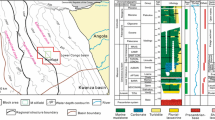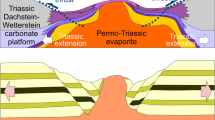Abstract
The Neoproterozoic Kansapathar Sandstone of the Chattisgarh basin, a shallow marine shelf bar sequence, consists of mineralogically and texturally mature sandstones with subordinate siltstones, mudstones and conglomerates. The sediments were transported, reworked and deposited in subtidal environments by strong tidal currents of macrotidal regime as well as storms, and accumulated as discrete shoaling-upward features, separated from each other by muddy to low-energy sandy deposits. The sandbodies developed into shoaling up linear bars, often more than a kilometre in length, through accretion of thick cross-stratified units in transverse directions under the influence of ebb and flood tidal currents, as well as in longitudinal direction affected by southeasterly flowing along-shore currents. The aggrading upper surfaces of the bars experienced protracted reworking by strong oscillatory wave currents leading to extensive development of subaqueous 2D or 3D dunes mantled with lag pebble deposits at different points. With continued shoaling and progradation, the bars amalgamated into large sandstone sheets with the development of high energy beach deposits and coastal sand flats in the uppermost part of the sequence. The presence of rill marks, flat-topped ripples, wrinkle marks, desiccation cracks and adhesion warts point to intertidal conditions with intermittent exposure. The high energy sandstone bars overlie a thick mudstone-dominated shelf sequence across a sharp interface indicating rapid change in the sea-level, provenance, rate of sediment generation and sediment input, and circulation condition in the shelf. A quiet muddy shelf was replaced by a major sand-depositing environment with strong, open marine circulation. An interplay of tidal currents, oscillatory wave currents and storm currents generated a complex flow pattern that varied in time and space from bimodal-bipolar to strongly unimodal flows.
Close parallelism of wave ripple crests, trend of linear bars and unidirectional flows suggest that the elongate bars were parallel to sub-parallel to the coastline, and were strongly influenced by along shore drift. The inferred coastline was broadly N-S. The large-scale structures in the bar sandstones, emplacement of vast amount of sand and migration of large bedforms under strong macrotidal currents collectively indicate that the Kansapathar shelf was intimately connected with an open ocean basin towards north-northwest.
Similar content being viewed by others
References
Allen J R L 1980 Sand waves; a model of origin and internal structure;Sedimentary Geology 26 281–328.
Allen J R L 1982 Sedimentary structures: their character and physical basis;Developments in Sedimentology 30A & B Amstardam, Elsevier.
Allen P A and Homewood P 1984 Evolution and mechanics of a Miocene tidal sandwave;Sedimentology 31 63–81.
Anderton R 1976 Tidal-shelf sedimentation; an example from the Scottish Dalradian;Sedimentology 23 429–458.
Ashley G M 1990 Classification of large scale subaqueous bedforms: A new look at an old problem;J. Sed. Petrol. 60 160–172.
Banks N L 1973 Tide-dominated offshore sedimentation, lower Cambrian, North Norway;Sedimentolology 20 213–228.
Bluck B J 1967 Sedimentation of beach gravels: examples from south Wales;J. Sed. Petrol. 37 128–156.
Boersma J R 1969 Internal structure of some tidal megaripples on a shoal in the Westerschelde estuary, the Netherlands; report of a preliminary investigation;Geol. Mijnbouw 48 409–414.
Boersma J R and Terwindt J H J 1981 Neap-spring tide sequences of intertidal shoal deposits in a mesotidal estuary;Sedimentology 28 151–170.
Brenner R L and Davies D K 1974 Oxfordian sedimentation in western interior United States;Am. Assoc. Petrol. Geol. Bull. 58 407–428.
Chaudhuri A K and Howard J D 1985 Ramgundam Sandstone; a Middle Proterozoic shoal-bar sequence;J. Sed. Petrol. 55 392–397.
Chaudhuri A K, Mukhopadhyay J, Patranabis Deb S and Chanda S K 1999 The Neoproterozoic cratonic successions of Peninsular India;Gond. Res. 2 213–225.
Clifton H E 1973 Pebble segregation and bed lenticularity in wave-workedversus alluvial gravel;Sedimentology 20 173–187.
Clifton H E 1976 Wave-formed sedimentary structures; a conceptual model, In: Beach and near shore Sedimentation (eds) R A Davis Jr. and R L Ethington,SEPM Spec. Publ. 24 126-148.
Clifton H E, Hunter R E and Phillips R L 1971 Depositional structures and processes in the non-barred, high energy nearshore;J. Sed. Petrol. 41 651–670.
Dalrymple R W, Knight R J and Lambiase J J 1978 Bedforms and their hydraulic stability relationships in a tidal environment, Bay of Fundy, Canada;Nature 275 100–104.
Das D P, Ganguly Das M and Arora Y K 1990 Microfacies assemblage of Gypsum from Chattisgarh Basin A Sabkha model of Evaporite Formation in Precambrian of Central India,Geol. Surv. India, Spec. Publ. 28 639–647.
De Raaf J F M, Boersma J R and Gelder A 1977 Wavegenerated structures and sequences from a shallow marine succession, Lower Carboniferous, County Cork, Ireland;Sedimentology 24 451–483.
Deynoux M, Duringer P, Khatib R and Villeneuve M 1993 Laterally and vertically accreted tidal deposits in the Upper Proterozoic Madina-Kouta Basin, southeastern Senegal, West Africa;Sed. Geol. 84 179–188.
Dupré W R, Clifton H E and Hunter R A 1980 Modern sedimentary facies of the open Pacific coast and Pliestocene analogs from Monterey Bay, California. In:Quaternary Depositional Environment of the Pacific coast (ed.) M E Field,SEPM Pacific Section, Tulsa, Pp. 105-120.
Ethridge F G and Wescott W A 1984 Tectonic setting, recognition and hydrocarbon reservoir potential of fan delta. In: Sedimentology of Gravels and Conglomerates (eds) E H Koster and R J Steel,Canadian Soc. Petrol. Geol. Mem. 10 217-235.
Fisher R V 1971 Features of coarse grained, high concentration fluids and their deposits;J. Sed. Petrol. 41 916–927.
Ginsburg R N 1975 Tidal deposits; casebook of recent examples and fossil counterparts (New York: Springer-Verlag) p. 428.
Imbrie J and Buchanan H 1965 Sedimentary structures in modern carbonate sands of the Bahamas. In: Primary Sedimentary structures and their hydrodynamic Interpretation (ed.) G V Middleton,SEPM Spec. Publ. 12 149-172.
Johnson A M 1970 Physical Processes in Geology: Freeman, San Fransisco Cooper and Co., p. 577.
Jopling A V 1965 Hydraulic factors controlling the shape of laminae in laboratory deltas;J. Sed. Petrol. 35 777–791.
Klein G De V 1971 A sedimentary model for determining paleotidal range;Geol. Soc. Am. Bull. 82 2585–2592.
Kohsiek L H M and Terwindt J H J 1981 Characteristics of foreset and topset bedding in megaripples related to hydroclynamic conditions on an intertidal shoal. In: Holocene Marine Sedimentation in North Sea (eds) S D Nio, R T E Shuttenhelm and T C E Van Weering,Int. Assoc. Sed. Spec. Publ. 5 27–37.
Kreisa R D and Moiola R J 1986 Sigmoidal tidal bundles and other tide-generated sedimentary structures of the Curtis Formation, Utah;Geol. Soc. Am. Bull. 97 381–387.
Kruezer H, Karrc W, Kursten M, Schnitzer W A, Murti K S and Srivastava N K 1977 K-Ar dates of two glauconites from the Chandarpur Series (Chattisgarh/India); on the stratigraphic status of the late Precambrian basins in central India;Geologisches Jahrbuch B28 23–36.
Leckie D A 1988 Wave formed, coarse-grained ripples and their relationship to hummocky cross-stratification;J. Sed. Petrol. 58 607–622.
Levell B K 1980a Evidence for currents associated with waves in late Precambrian shelf deposits from Finnmark, North Norway;Sedimentology 27 153–166.
Levell B K 1980b A late Precambrian tidal shelf deposit, the Lower Sandfjord Formation, Finnmark, North Norway;Sedimentology 27 539–557.
Lowe D R 1982 Sediment gravity flow II: depositional models with special reference to the deposits of high-density turbidity currents;J. Sed. Petrol. 52 279–297.
Maejima W 1982 Texture and stratification of gravelly beach sediments, Enju Beach, Kii Peninsula, Japan;Jp. Geosci. Osaka City Univ. 25 35–51.
Massari F and Parea G C 1988 Progradational gravel beach sequences in a moderate to high-energy, microtidal marine environment;Sedimentology 35 881–913.
McCubbin D G 1982 Barrier-island and strand-plain facies. In: Sandstone Depositional Environments (eds) P A Scholle and D Spearing,Am. Assoc. Petrol. Geologist Tulsa 31 247-279.
Middleton G V and Hampton A I 1976 Subaqueous sediment transport and deposition by sediment gravity flows. In:Marine Sediment Transport and Environmental Management (eds) D J Stanley and D J P Swift (New York: Wiley) Pp. 197–218.
Moitra A K 1995 Depositional environmental history of the Chattisgarh basin, M.P., based on stromatolites and microbiota;J. Geol. Soc. India 46 359–368.
Murti K S 1996 Geology, sedimentation and economic mineral potential of the south-central part of Chattisgarh Basin;Geol. Surv. India Mem. 125 139.
Nemec W and Muszyñski A 1982 Volcaniclastic alluvial aprons in the Tertiary of Sofia district (Bulgaria);Annales Societatis. Geologorum Poloniae 52 239–303.
Nemec W and Steel R J 1984 Alluvial and coastal conglomerates; their significant features and some comments on gravelly mass-flow deposits. In: Sedimentology of Gravels and Conglomerates (eds) E H Koster and R J Steel,Canadian Soc. Petrol. Geol. Mem. 10 1–31.
Patranabis Deb S 2001 Purana (Proterozoic) Stratigraphy and Sedimentation in the Eastern part of the Chattisgarh Basin: a fan delta motif; Unpub. Ph.D dissertation (Jadavpur University, Kolkata) p. 169.
Reineck H E and Singh I B 1986 Depositional Sedimentary Environments. 2nd Edn. (Berlin: Springer-Verlag) p. 543.
Reinson G E 1984 Barrier island and associated strand plain systems. In: Facies models, 2nd Edn. (ed.) R G Walker,Geol. Assoc. Canada, Geoscience Canada. Reprint Series 1 119-140.
Roep T B, Beets D J, Dronkert H and Pagnier H 1979 A prograding coastal sequence of wave-built structures of Messinian age, Sorbas, Almeria, Spain;Sedimentary Geology 22 135–163.
Sarkar A, Sarkar G, Paul D K and Mitra N D 1990 Precambrian geochronology of the central Indian shield a review;Geol. Surv. India Spec. Publ. 28 453–482.
Singh I B and Wunderlich F 1978 On the terms wrinkle marks (Runzelmarken), millimetre ripples, and mini ripples;Senckenbergiana maritima 10 75–83.
Tankard A J and Hobday D K 1977 Tide-dominated back-barrier sedimentation, early Ordovician Cape Basin, Cape Peninsula, South Africa;Sedimentary Geology 18 135–159.
Terwindt J H J 1971 Litho-facies of inshore estuarine and tidal-inlet deposits:Geol. Mijnbouw 50 515–525.
Van Straaten L M J U 1953 Rhythmic pattern on Duch North Sea beaches;Geol. Mijnbouw 15 31–43.
Visser M J 1980 Neap-spring cycles reflected in Holocene subtidal large-scale bedform deposits; a preliminary note;Geology 8 543–546.
Walker R G 1985 Ancient examples of tidal sand bodies formed in open, shallow seas. In:Shelf sands and sandstone reservoirs (eds) R W Tillman, D J P Swift and R G Walker,SEPM Short Course Notes 13 303-340.
Author information
Authors and Affiliations
Rights and permissions
About this article
Cite this article
Deb, S.P. Tidal shelf sedimentation in the Neoproterozoic Chattisgarh succession of central India. J Earth Syst Sci 114, 211–226 (2005). https://doi.org/10.1007/BF02702946
Issue Date:
DOI: https://doi.org/10.1007/BF02702946




